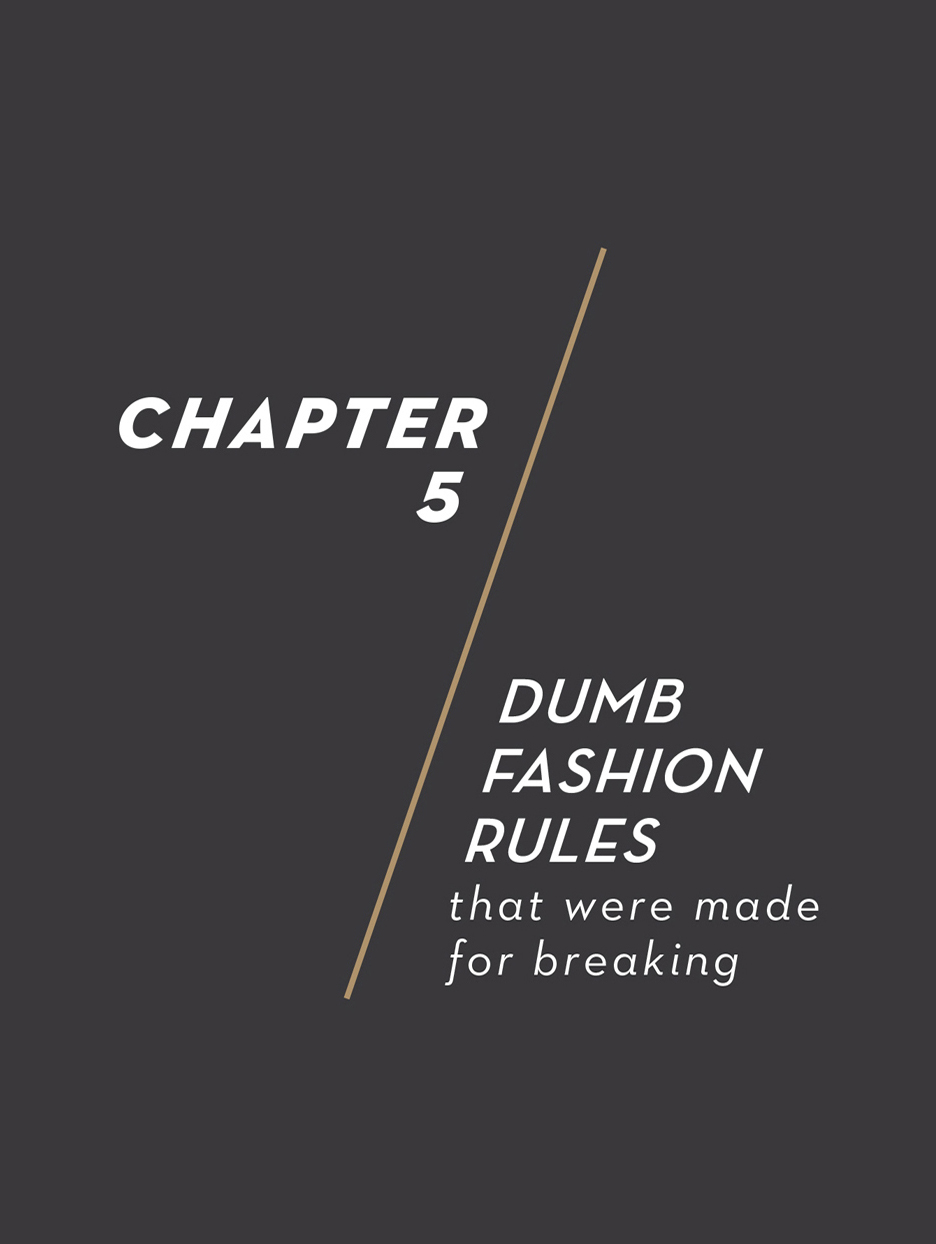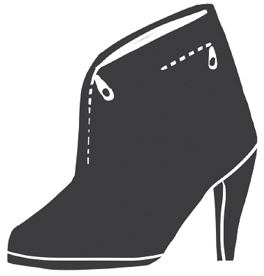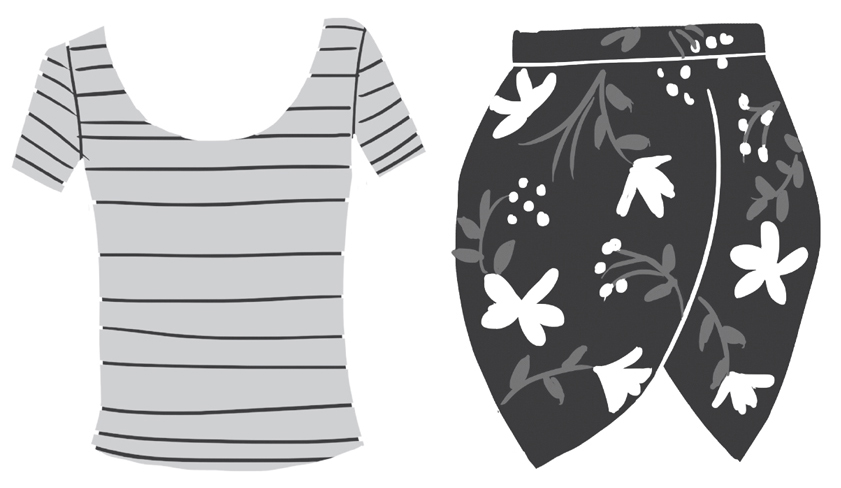


As a natural-born scofflaw, I despise almost all rules. And rules in fashion are particularly infuriating. Most of them are meant to trick us into dressing and acting exactly alike, which is dumb. I’ve always thought the “don’ts” in the back of magazines looked far more interesting than the perfect models on the preceding pages. The idea that “women should refrain from wearing shorter skirts past age forty,” or that we should all “avoid wearing red with pink” is, in a word, totally boring. (Yeah, that’s two words, but forget the rules, remember?)
Having great style is all about being different, unique, and, above all else, interesting. (Plus, wearing whatever the hell you want every day is at least five hundred times easier than remembering a bunch of antiquated dos and don’ts.) But if you need some extra reassuring, here are my top ten really dumb fashion rules that you should definitely toss into the wind without a care—because really, who’s going to stop you?
I’ve had hundreds, if not thousands, of heated conversations with actors who are stuck believing this outdated rule. The old wisdom has always been that vertical stripes are more flattering than horizontal ones, but you might be surprised to find that the exact opposite is true. When your eye looks at vertical stripes on a body, it has to do a lot of work to take in the breadth of contrast. That’s because when viewed from head to toe, vertical stripes warp where they skim over the wearer’s breasts, hips, and shoulders, causing the brain to work harder to process what it is seeing. All this extra thinking then fools the brain into believing that the area is bigger than it actually is. But when the stripes run from left to right, there’s a single unbroken line—so there’s zero shape confusion for the brain to sort out. Because when the brain glosses over a detail, the eye does, too!

What is true is that the skinnier the stripe, the more the eye is fooled. A good equation to follow for stripe placement is 10 percent of the darker color and 90 percent of the lighter. But in the end, it’s really the fit of the garment, not the width or placement of the stripes that determines if it works for you or not. And that is something only you can answer—no antiquated rules can help you figure it out. The bottom line is this: if you like stripes, then wear them without fear!
This rule was originally “Don’t wear white shoes after Labor Day” but has somehow expanded to include white clothing as well. There are many theories as to how it actually became a rule—some say it was a way to show that one was a member of the leisure class and could afford to have an entire, separate summer-specific wardrobe. Fashion magazines of the early 1900s really cemented this rule in their editorial pages, likely in an attempt to keep Madame So-and-So from sullying her pristine summer lawn-party ensembles with mud from the heavy fall rains.
The laughable part of this made-up “rule” is that the real tastemakers of the day didn’t subscribe to this theory even back then. Coco Chanel herself wore white year-round! And how else do you explain “winter whites”? I’d suggest avoiding linen, seersucker, and other very summer-specific fabrics in the winter, but other than that, it’s game on for white clothes whenever you feel like looking angelic. (And if white is only acceptable for a few months out of the year, then why is a crisp white blouse on every single “must-have wardrobe items” list written since time immemorial?)
As for the white shoes, they are a bit of a challenge to keep clean in inclement weather. But the sense of lightness they give a dull winter outfit is well worth the hassle. As long as they aren’t open-toed and strappy, I say you should slog through the slush in the middle of January in your white shoes and be happy—because it’s really nobody’s business what you do to please yourself.
Hear me now: A brown belt is always the perfect foil for a black dress. It adds a sense of lightness that a solid black dress is inherently missing—while keeping the overall look low-key. Just make sure it’s a lighter shade of brown for maximum contrast and always repeat a spot of brown somewhere else in your outfit, whether it’s a leather cuff, a cardigan, your shoes, or your handbag.
And exactly what color shoe are you supposed to wear with a navy dress—matchy-matchy navy ones? Black footwear works well with navy or blue-black garments, but the real truth is that a black shoe grounds almost any outfit and gives it the sharp edge that a dainty, matching shoe never can. You can also successfully pair a cognac, tan, or oxblood shoe with any navy frock for a very chic Italian street–style look. Try it—I bet you’ll like it!
Mixing jewelry metals is not only okay, it’s awesome. The more the merrier! A brilliant melody of metal tones is the total cool-girl secret to laid-back, laissez-faire style. If it wasn’t, then how do you explain the enduring popularity of the Cartier “Trinity” ring, a classic since 1924 that consists of interlocking bands of pink, yellow, and white gold? But there’s a secret to pulling it off—and it lies in always wearing a third piece that matches one you already have on, so it’s not just a silver ring with a pair of gold earrings. You need to then add either a handbag with gold hardware or a necklace in silver to even out the look. I find that a simple set of bangles that mix silver and gold together give you an instant license to wear any other mixed metal colors you want at the same time.

Also, try adding a pinch of rose gold to your current jewelry rotation. It has a warm, luscious quality that goes with everything and flatters all skin tones. Look for a rose gold–hued ring or pair of stud earrings you can wear every day and plug other metals in with it at will. It’s a great way to ease yourself into being a metal mixer!
Here’s the fashion world’s most boring question: “Are leggings pants?” Of course they are! You can’t keep people from loving a single garment that can take you from your bed, to the gym, to work, then out to dinner, and back to bed with ease. Sure, we’ve all been exposed to a certain amount of shocking information about other people’s private regions due to some too-sheer, too-tight pairs of leggings, but it’s a small price to pay for such supreme comfort. I personally strive to pair my leggings with tops that at least graze my pubic bone, but it’s really your divine right to wear yours as you see fit.
If you are a staunch defender of the “leggings aren’t pants” rule, do yourself a favor and look into trying a double-knit pair, commonly known as ponte pants. They are a bit thicker and firmer than regular leggings but are just as comfy and stretchy. Ponte pants often have pockets or zippers, further legitimizing their status as actual pants—that just so happen to be crazy comfortable!
Before you leave the house, check your leggings for sheerness by taking a test photo of your backside using your phone’s camera. Be sure to turn on the flash—because the harsh light of day reveals secrets that your dimly lit bedroom wants to keep from you. If there is any hint of sheerness, layer a long, bum-covering tank under your shirt to keep your assets under wraps. (And don’t forget to delete those photos ASAP!) The making of leggings that are too sheer at the backside should be considered a crime—punishable by many years of hard labor, all overseen by the affected women.
The person who decreed this to be a fashion “rule” has obviously never had the misfortune of rolling an entire wardrobe rack full of clothes over the top of his or her bare flip-flopped foot. Life is inherently dangerous, and a great pair of boots helps protect your tootsies from harm. I wear boots to work every single day (no matter what the weather) after breaking half my toes in the aforementioned rack mishap. The trick is to make them look warm weather–appropriate and not cause passersby to wonder how much your feet must be sweating. (Although really, they should just mind their own darn business.) Keeping your boots at ankle height, your legs totally bare, and avoiding socks that look heavy or knitted usually does the trick. Choosing a pair of boots in a pale color to drive home the summertime vibe also keeps the overall look from becoming too wintry. Taller boots can work in the summertime, too—but always with taller socks or even sheer knee-highs to avoid gruesome shin sweat!
If you have sturdier legs, it’s true that a pair of boots that hits you at midcalf is not the best choice. (They can also tend to overwhelm a petite frame.) But boots that hit right at the anklebone flatter every single body type there ever was. If you’re concerned about drawing too much attention to your legs, look for a simple boot without a ton of embellishment—and pair them with knee socks to ape the look of taller boots if you need to ease yourself into feeling comfortable going bare-legged with them. I also think ankle boots on shorter legs can actually fool the eye into thinking the reason your legs look shorter is due to the boots—and not the other way around.

Wearing contrasting patterns used to be dismissively called “clashing” and was something we were all advised to avoid. But truly fashionable women know that the secret to incredible style lies in knowing how to effortlessly mix patterns without going overboard. It’s also a great way to expand your closet without spending a dime. If the secrets of masterful pattern mixing seem impossible to crack, I’m not surprised—when it goes wrong, it goes really, horribly wrong. Luckily there are some simple guidelines you can follow to achieve the perfect “mismatched” look—and they are almost impossible to mess up:

+ Keep it in the same color family. A head-to-toe solid-color outfit can veer into Jolly Green Giant territory very quickly—but a monochromatic color story is actually a great way to test the pattern-mixing waters while still maintaining a cohesive look. It’s also a safe way to try your hand at pattern mixing in a conservative workplace. If you’re a beginner, choose neutral-colored pieces (like brown or nude) done up in perky florals and zesty zigzags. Play it safe with your shoes, both in style and color, until you get your sea legs.
+ Echo the color of one pattern in the other. If you’re wearing a floral patterned shirt with a navy background on your top half, choose a skirt that incorporates a navy stripe for the bottom. The repeating color helps tone down the overall look and adds a sense of cohesiveness that can feel missing from some mixed-pattern masterpieces. (It’s also a good trick to fall back on when all else fails!)
+ Treat houndstooth, polka dots, thin stripes, and checks as solids. Classic, repeating patterns work beautifully when they are small and understated enough that your eye can understand them as solid colors—even though they obviously are not! This includes highly textured fabrics like nubby, Chanel-esque tweed pieces. Wear your favorite ultraclassic patterns as if they are solid neutrals, pairing them with a different patterned piece that repeats one of the other garment’s base colors somewhere on itself. If you’re feeling particularly adventurous, plug in a camouflage or leopard piece for extra credit. They are the wild cards of the pattern-mixing master class—freaky enough to still be edgy yet classically recognizable in their own way.
+ Pay attention to scale and size. An easy shortcut to mastering pattern mixing is playing with scale. When you mix a larger print with a smaller one, they have the effect of balancing one another out—making one print the hero of the outfit story and the other its loyal sidekick. I tend to think the larger print should be on the bottom half of the outfit, as it grounds the look somewhat, but I’ve also seen the opposite work, too—which is just further proof that fashion rule makers don’t always know what’s best for you in particular. All style advice should be taken with a grain of salt, even when it’s from me.
+ Always mix in a solid or neutral piece. A patterned shirt with a solid bottom and a contrasting, patterned shoe is an easy way to wear whatever the hell you want and still look office-appropriate. A neutral or solid piece can go a long way toward breaking up a too-fierce pattern mix. It also gives the eye a little relief from an overdose of visual excitement. If you need to tone down a pattern mix fast, classic navy is always your loyal, foolproof friend.
+ Test drive it first. Pattern mixing takes a certain amount of self-confidence, so make sure to road test your first attempts at it somewhere low impact—like for a day of running mindless errands. Your maiden pattern-mixing voyage shouldn’t be anywhere high pressure like a wedding or school reunion. Wear it to the grocery store first—then, after someone compliments you on it, graduate to wearing it to work. It gets way easier every time you attempt it, I promise.
Wearing denim-on-denim has been a solid fashion “don’t” forever. But street style has blown right past that old idea, and it’s now a totally cool fashion “do.” However, there actually are a few rules to making it work.
This isn’t a look for wallflowers. You’ll need to make the whole point of your outfit the fact that yes, you are in fact boldly rocking denim on denim, and what of it? Don’t be afraid to pair a pale blue, lightweight chambray shirt in a small repeating pattern with a pair of darker-wash boyfriend-style jeans. The trick is to mix the weights and shades of the denims you are wearing together. That way the look becomes all about contrasts in texture. Roll up your cuffs and finish the look with a pair of low-top white canvas sneakers and bare ankles. Two pieces of denim is really the max you should wear at any one time—but if you’re feeling brave, you can match a pair of denim-accented kicks or a vintage jean handbag with your outfit and be the coolest kid in class.
The idea that your wardrobe can’t echo your hair color is as antiquated as the idea that blondes have more fun. But notice I said echo—not match—because to successfully pull off wearing a garment the same color as your hair, you’ll need to choose a hue that flatters your locks instead of fighting them.
I once heard a snarky fashion commentator call a beautiful redheaded actor wearing a red dress a “walking valentine.” I just rolled my eyes, because a redhead in the right shade of fiery red is a true thing of beauty, life, and vitality. The trick to a redhead wearing red successfully lies in finding a shade that is both richer and more intense than her hair:
+ Redheads whose hair is an orangey red should look for brighter blue-reds. (These colors look especially great with green or blue eyes.)
+ Redheads with hair in the brownish-auburn family should look for warmer, spicier reds that lean toward orange (including tomato red and paprika tones). The more brown the hair is, the more shades of red can be worn with ease.
+ Strawberry blondes look fabulous in clear, pinky reds but should avoid anything that has dusty overtones. Muddied colors have a tendency to look drab and dirty on pale redheads.
+ Coppery-toned redheads will get a lot of mileage out of true scarlet reds but should avoid any red that veers toward orange. Copper-colored hair already gives the look all the warmth it needs.
+ When wearing red, redheads should make sure to avoid higher-necked garments—they have a tendency to overpower the face with too high a dose of red-on-red goodness.
Yellow is a color that automatically conjures up wholesome images of lazy summer afternoons and cheerful daydreams. Yellow is also a color that doesn’t hog the spotlight and actually works quite well on blondes due to its inherently muted nature:
+ White or platinum blondes should look for bright sunshine and deep mustard hues but avoid pale yellow, which has a tendency to wash them out.
+ Champagne blondes can wear buttery yellow and lemon shades with ease but should pass on yellows that have an orange cast to them, because they tend to fight with the beige undertones champagne blondes naturally (or unnaturally!) have.
+ Butterscotch blondes can successfully wear almost any shade of clear yellow—but really pop in pineapple and taxi yellows.
+ Ashy blondes can pull off canary yellow and citron hues with surprising ease but should avoid wearing mustard yellow. It has a tendency to look drab next to hair with olive undertones.
+ All blondes can tone down a flat, blonde-on-yellow look by adding a piece in a color flattering to blondes into the mix. Navy and cognac both pair well with yellow and really make blonde hair pop.

Just because some boring nerd somewhere decided that we should all blindly follow a bunch of made-up fashion rules doesn’t mean we have to obey. For every fashion “rule” ever written, there’s just as compelling a reason to break them. So fly in the face of authority and carry on with your bad self, ya hear?